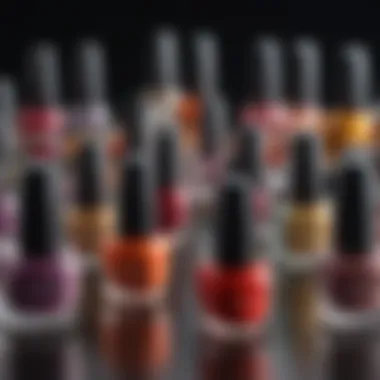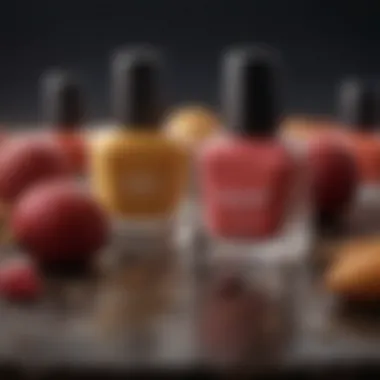Nail Colors That Complement Your Skin Tone


Intro
The exploration of nail colors highlights a crucial aspect of personal style. The right shade can bring out the best in an individual’s skin tone, enhancing the overall appearance. With a multitude of nail polish options available, the selection process becomes intricate yet personal. By understanding various factors like skin undertones and seasonal trends, one can make informed choices that resonate with individual aesthetics. This article will delve into these components, aiming to empower readers by providing insights into selecting nail colors that complement their unique complexion.
Fashion Trends
Nail colors are often influenced by the latest fashion trends, reflecting what is popular in the realm of beauty and style.
Seasonal Styles
Each season presents a distinct palette. For instance, during the spring, lighter pastel shades like lavender, mint green, and soft pink dominate the scene, embodying the freshness of the season. In contrast, autumn often calls for deeper colors such as burgundy, burnt orange, and earthy browns, mirroring the changing leaves. Winter months tend to showcase more dramatic colors, such as dark blues and blacks, often accented with metallic or glittery finishes.
Influencer Inspirations
Social media significantly shapes nail color trends. Influencers often introduce unique shades and combinations that spark interest among their followers. Keeping an eye on platforms such as Instagram or Pinterest can provide inspiration for the next manicure. Color palettes showcased by influential figures can also highlight how various shades can work effectively with different skin tones.
Understanding how popular styles change with the seasons helps one choose nail colors that feel timely and relevant.
Beauty Tips
Choosing the right nail color is only part of the process. There are beauty tips that can help enhance the overall look.
Skincare Routines
A good skincare routine lays the foundation for showcasing flawless nails. Healthy hands and nails exhibit better color adherence and shine. Incorporating regular moisturizing and exfoliation can prevent dryness and enhance nail polish application. Products like cuticle oils and hand creams play a significant role in maintaining nail health.
Makeup Techniques
Makeup can also influence nail color choices. When selecting a nail polish, consider the makeup hues applied on the face. For example, if warm tones dominate the makeup palette, warmer nail colors, like coral or peach, will harmonize well. Conversely, cool shades like bluish reds may be more suitable for cooler complexions and makeup tones.
Product Reviews
With numerous nail products available, it is essential to be informed about trending options.
Trending Products
Emerging brands like OPI and Essie offer a range of shades that cater to diverse skin tones. Both brands frequently update their collections to reflect current trends. Knowing which products to try can assist readers in achieving their desired look.
Comparison Guides
Not all nail polishes are created equal. Comparing products based on finish, longevity, and ease of application can guide decisions. A detailed review between gel versus traditional nail polish can also educate readers on which may better suit their lifestyle.
In summary, choosing nail colors extends beyond mere aesthetics. An understanding of trends and available products, along with personal preferences and skin tones, can lead to optimal choices in nail polish that enhance one’s appearance and style.
Understanding Skin Tones
Understanding skin tones is a crucial aspect of selecting nail colors that enhance one's overall appearance. It is not purely a matter of personal preference; rather, it relates to the interplay between individual complexion and the hues that complement or contrast with it. Recognizing one's skin tone helps in identifying which nail colors are most suitable, thereby ensuring that they look their best. This section will explore the foundational elements of skin tone, highlighting the importance of undertones, and placing skin tones into various categories.
Defining Skin Tones
Skin tone is the natural color, texture, and appearance of one's skin. It varies immensely among individuals and can be influenced by several factors including genetics, environment, and health. In the context of nail polish selection, understanding skin tone aids in choosing shades that resonate well with one's natural coloring. The primary classifications of skin tones are often described as fair, medium, olive, and deep. Each category has its unique characteristics, and recognizing where one fits can dramatically improve nail color choices.
The Importance of Undertones
Undertones are the subtle hues beneath the skin’s surface that affect how colors appear on an individual's skin. There are three main types of undertones: cool, warm, and neutral. Knowing your undertone is crucial. For instance, a person with cool undertones may choose nail colors that have blue or violet bases. In contrast, warm undertones might find richer, golden shades more flattering. This vital information guides the selection of nail colors that align not just with the skin tone but also with individual personality and style preferences.
Categorizing Skin Tones
The analysis of skin tones can be classified into three primary categories.
Cool Undertones


Cool undertones tend to have a rosy, pink, or bluish hue. People with this undertone often find that silver jewelry complements their skin most, as opposed to gold. Choosing nail colors like navy blue, cool reds, and purples work exceptionally well for those with cool undertones. The benefit of identifying as having cool undertones is having a diverse range of shades that stand out. However, some brighter colors may appear excessively vivid, requiring careful selection.
Warm Undertones
Warm undertones are characterized by a yellow, peachy, or golden hue. Those who possess warm undertones typically look best in gold jewelry. Colors such as corals, warm pinks, and earthy shades tend to flatter this skin type. Recognizing warm undertones is advantageous because it allows for selections that enhance the natural glow of the skin. Some darker or cooler shades may clash, so being aware of this helps prevent poor choices.
Neutral Undertones
Neutral undertones represent a balance between cool and warm. Individuals with neutral undertones can wear a wider array of colors, from both warm and cool palettes. They may notice that both silver and gold jewelry suits them. This flexibility in color choice heightens the appeal of neutral undertones, making it easier to explore different nail color trends. Nevertheless, certain colors may sometimes appear washed out, so caution is still necessary when making selections.
Understanding the intricacies of skin tones and undertones can dramatically affect your nail color choices, ensuring a harmonious look.
Choosing Nail Colors
Choosing the right nail colors is not merely an aesthetic choice. It reflects an individual's personality and style while also complimenting their unique skin tone. Selecting an appropriate nail polish can enhance one's overall appearance, boosting self-confidence and personal expression. Understanding the factors that influence color selection is paramount. This article discusses these factors, ensuring an informed approach to choosing nail shades that resonate with personal identity.
Personal Style and Preferences
Every individual has distinct tastes when it comes to colors. For some, bold, vibrant shades reflect a lively personality. Others may prefer muted tones that exude sophistication. It is essential to consider how personal style plays a role in color selection. It is not just about matching a nail color with an outfit; it is about finding shades that resonate on a personal level.
When selecting nail colors, one should consider how colors make one feel. Are certain colors associated with fond memories? Do they evoke specific emotions? Understanding this connection can aid in making the right choice. A well-chosen color can amplify confidence. Whether it is a classic red, a soft nude, or a rich berry, each option sends a message about the wearer. Moreover, incorporating trends into one's choices can enhance personal flair. However, these trends should align with individual preferences.
Seasonal Influences in Selection
Seasons have a profound impact on the colors that draw attention. During spring, pastel hues often dominate, while summer welcomes vibrant and lively tones. Autumn tends to favor warm, earthy shades, whereas winter introduces darker, richer colors. Understanding these seasonal shifts can help in choosing nail colors that feel timely and appropriate.
Moreover, it’s practical to think about occasions too. Holiday celebrations might inspire glittery finishes, while casual outings may call for understated shades. This acknowledges the relationship between environment and color choice. Adapting one's nail color to align with seasonal themes can foster a more coherent overall appearance.
Color Psychology and Perception
Colors do more than just please the eye; they also affect moods and perceptions. Each color carries specific psychological associations that can influence how a person is perceived. For instance, red often conveys confidence and power, while blue is associated with calm and professionalism. Understanding these associations can help individuals choose nail colors that align with the impression they wish to leave.
Consider how colors reflect personality traits. Bold shades may imply a daring spirit, while softer tones reflect a more reserved nature.
"Choosing the right nail color can evoke feelings of joy, confidence, and empowerment."
Individuals can use color psychology to suggest aspects of their identity. Thus, it becomes crucial to choose colors not only for their visual appeal but also for their psychological impact. Overall, the compelling intersection of color psychology and personal style serves as a foundation for making informed choices in nail color selection.
Recommendations by Skin Tone
Choosing nail colors based on skin tone is not just about aesthetics; it is about finding shades that amplify one’s natural beauty. This section will explore how different skin tones affect nail color choices and why these recommendations matter. Understanding the nuances of skin tone can lead to more satisfying choices and can enhance overall appearance. Selecting the right colors helps create a polished and cohesive look, while the wrong shades may diminish one's natural glow.
Nail Colors for Cool Skin Tones
Cool skin tones typically feature pink, red, or blue undertones. Choosing the right nail colors can create harmony and balance, enhancing one’s natural complexion.
Best Shades
For those with cool skin tones, the best shades include royal blues, deep purples, and cooler reds. The characteristic of these colors is their ability to complement and enhance the blue and pink undertones found in cool skin tones. Additionally, shades like icy pastels can provide a fresh look, reflecting a sense of elegance and modernity. A unique feature of these shades is their versatility; they work well in various settings, from casual outings to formal events.
Some benefits of these best shades:
- They create a striking contrast with cool undertones.
- They add depth and sophistication to one’s look.
Colors to Avoid
Conversely, certain colors do not align well with cool skin tones. Earthy hues like oranges, yellows, and certain browns can clash with the cool undertones. These colors often overpower and distract from the skin's natural hues. An important aspect of this section emphasizes that wearing colors that do not complement cool undertones may likely lead to a dull appearance.
Noteworthy features of colors to avoid include:
- They may draw attention away from one's features.
- Misaligned shades can cause skin to look washed out.


Nail Colors for Warm Skin Tones
Warm skin tones often display yellow, peach, or golden undertones. Selecting the right nail colors is crucial for enhancing these warm hues.
Best Shades
Rich reds, vibrant corals, and warm neutrals are fantastic options for warm skin tones. These colors perfectly balance the warmth of the undertones. One major characteristic of these nail colors is their ability to illuminate and bring warmth to the overall appearance. Shades like terracotta and sunshine yellow can also work well, adding a fresh vibrance.
Benefits of best shades for warm skin tones:
- They create a harmonious flow between the skin and nail color.
- These shades can lift the overall mood of the appearance.
Colors to Avoid
For warm skin tones, it is wise to steer clear of overly cool shades, such as leggy blues and stark whites. These colors often counteract the warmth and may wash out the complexion, leading to an unhealthy appearance. The unique feature of these avoided colors is their tendency to create a stark contrast that does not flatter.
Key points regarding colors to avoid:
- They can result in a disjointed look.
- Misplacing these colors can result in loss of vibrancy.
Nail Colors for Neutral Skin Tones
Neutral skin tones have a balanced mix of cool and warm undertones. Because of this, the selection of nail colors is particularly flexible, although there are still guidelines.
Best Shades
Nail colors such as mauves, soft taupes, and muted pinks work exceptionally well on neutral skin tones. These shades blend seamlessly with both warm and cool undertones. The characteristic that makes these colors stand out is their ability to complement any outfit without overwhelming the wearer. Unique to this range is that it can create an elegant look while still being understated.
Advantages of best shades include:
- They provide versatility for various settings and occasions.
- Maintain balance without drawing excessive attention.
Colors to Avoid
When dealing with neutral skin tones, overly bright or loud colors should be avoided. Shades like neon green or aggressive red can divert focus and may clash with the overall tone of the skin. A unique feature of these colors is their overpowering nature, which can overshadow an individual's natural beauty.
Considerations for colors to avoid:
- They may create visual imbalance.
- These colors can overpower subtle appearances.
Matching Nail Colors to Outfit
Matching nail colors to outfits is not just a matter of aesthetics—it is a significant element of personal style. The right nail polish can enhance an outfit, creating a more cohesive and polished overall look. It allows individuals to showcase their personality while paying attention to style details that are often overlooked. In this section, we will explore the nuances involved in coordinating your nail colors with your clothing choices and how it impacts your overall appearance.
Coordinating Colors
Coordinating nail colors with outfits involves selecting shades that complement or harmonize with the colors of your clothing. This process is akin to color theory in fashion design, where certain colors evoke specific feelings and perceptions. For example, if you are wearing a navy blue dress, nails painted in muted shades like light gray or deep red can create an elegant balance.
Key Considerations for Coordinating Colors:
- Color Wheel Understanding: Familiarizing yourself with the color wheel can help identify what colors blend well together. Warm colors like reds and yellows generally go well together, while cool colors, such as blues and greens, also complement each other.
- Seasonal Adaptations: Consider the season when choosing colors. For winter, deeper jewel tones like emerald or navy can work well. In contrast, pastel shades are often ideal for spring and summer.
- Outfit Patterns: If your clothing has a pattern, pick one color from the design for your nails. This can pull the outfit together and create a balanced look.
Contrast and Complementary Shades
Utilizing contrast and complementary shades can amplify the visual appeal of your overall appearance. Adding a contrasting nail color can make your hands stand out and add interest to your look. For instance, pairing a bold red nail with a white outfit can create a striking visual effect. On the other hand, selecting complementary shades can provide a more subtle and sophisticated aesthetic.
Effective Use of Contrast and Complementary Shades:
- Contrast Techniques: Use nail colors that are opposite on the color wheel from your outfit color. If you’re donning a blue top, consider an orange or coral for contrast. This can draw attention to your hands effectively.
- Complementary Choices: Choosing shades that are next to each other on the color wheel, such as blue and green or yellow and orange, can create a harmonious look, which is often pleasing to the eye.
- Mood and Occasion: Think about the context of your outfit. For professional settings, neutral or muted shades may be more appropriate, while bold colors might be ideal for casual outings or events.
"The interplay of color brings style to life, enhancing the unique expression of oneself."


In summary, matching nail colors to outfits plays a vital role in creating a cohesive image. By understanding how to coordinate colors, utilize contrasts, and consider mood, individuals can significantly enhance their overall style. This conscious choice aids in expressing personal preference while maintaining consideration for what works best for various occasions.
Nail Care and Maintenance
Nail care and maintenance is a cornerstone in achieving an appealing manicure. It not only enhances the appearance of nail colors but also contributes significantly to the health of the nails themselves. Proper care ensures nails are strong and less prone to breakage, which is crucial for showcasing vibrant nail colors effectively. Regularly caring for nails can also prevent issues such as peeling, chipping, and infection, ultimately leading to a more polished look.
Additionally, understanding the basics of nail care allows for better application of nail products. A well-prepped nail surface leads to longer-lasting polish and a more vibrant finish.
Preparation of Nails
Before applying any nail color, the preparation of nails is critical. Begin by removing any existing polish using a non-acetone remover to protect the nails from drying out. Next, wash your hands thoroughly to eliminate any residue.
Once clean, trimming and shaping the nails is essential. Use a nail clipper and a file to create the desired shape—whether oval, square, or almond. Make sure to file in one direction to prevent splitting.
Cuticles also play a significant role. Softening them with cuticle oil or cream will make them easier to push back. Use a cuticle pusher gently to avoid damaging the skin. Finishing this step with a nail buffer can create a smooth nail surface, enhancing polish adherence.
Long-lasting Finishes
The longevity of a nail polish application can be significantly improved through careful application techniques. Start with a base coat; this not only protects your nails from potential staining but also provides a surface for the color to adhere better. Once the base coat is dry, apply your chosen nail color in thin layers. Multiple thin coats are preferable to a thick one as they dry more evenly and are less likely to chip.
Don’t forget the top coat. This step is crucial for sealing in color and providing a glossy finish. It helps prevent chips and extends the life of your manicure. Additionally, when changing colors, wait for the polish to fully dry before applying another layer. This attention to detail can lead to significantly improved durability.
Common Mistakes to Avoid
There are several common mistakes that can undermine your nail care routine. Here are a few to watch out for:
- Skipping the base coat: This vital step protects your nails and enhances color adherence.
- Applying thick layers of polish: Thick layers can lead to bubbles and peeling.
- Neglecting cuticle care: Ignoring cuticles can lead to hangnails and infections.
- Using nails as tools: Avoid using your nails to open cans or scratch surfaces, as this can lead to breakage.
"Treat your nails with care – they are your best accessory."
By cultivating a consistent nail care routine and avoiding these pitfalls, you can improve not only the health of your nails but also the vibrancy and longevity of the nail colors you choose.
Trends in Nail Color
Understanding trends in nail color is essential for anyone looking to elevate their style. Nail color is not just a personal choice but a form of self-expression influenced by several factors. These trends reflect cultural shifts, societal influences, and even changes in the beauty industry. Being aware of these trends empowers individuals to make well-informed choices that align with their personal aesthetics and the current fashion landscape.
Current Popular Colors
Currently, certain colors dominate the nail polish scene. These colors often change with the seasons and fashion cycles.
- Neutral Tones: Shades like beige, taupe, and soft gray are trending. They provide versatility and work well with any outfit.
- Bold Reds: Classic red remains a steadfast choice. It exudes confidence and sophistication, making it a top pick.
- Soft Pastels: Light pinks, lavender, and mint green offer a fresh feel. They are particularly popular in the spring and summer.
- Dark Shades: Deep plum and navy blue are favorites in the colder months. These colors offer a dramatic flair.
Each of these shades can be matched to various skin tones, enhancing overall appearance.
Predictions for Future Trends
Looking ahead, several trends appear poised to take center stage in nail color.
- Metallics and Glitter: As seen on runways, metallic shades are gaining momentum. They add an eye-catching element, with gold and silver being top contenders.
- Earthy Tones: Colors inspired by nature, such as terracotta and sage green, may rise in popularity. Such hues resonate well with sustainable fashion movements.
- Color-Changing Polishes: Technology is influencing nail products. Polishes that change color with temperature or light may soon become more accessible.
- Personalization: Custom nail colors that cater to individual preferences are likely to trend. This idea reflects a broader movement towards uniqueness in beauty.
"Understanding the trends in nail color allows you to not only stay fashionable but also express your individual style effectively."
Staying informed about current popular colors and future predictions aids in selecting flattering shades that complement skin tones. Being aware of these trends helps instill confidence and encourages self-expression, making it a vital aspect of choosing nail colors.
Finale
Selecting the right nail color is more than a cosmetic choice; it is a reflection of personal style and identity. Nail colors can influence how one feels and how others perceive them. Throughout this article, we explored various facets of nail color selection, especially in relation to skin tones.
Understanding skin tones and their undertones is crucial. It allows for a more tailored approach when choosing nail polishes that not only enhance the hands but also complement the overall look. Recommendations provided for cool, warm, and neutral skin tones serve to guide choices, ensuring a harmonious match.
Furthermore, matching nail colors with outfits and keeping up with current trends are important considerations. These elements help in creating a cohesive appearance, whether it be for casual outings or special events. Maintaining nail care and ensuring longevity of nail color also deserve attention. Adopting best practices can lead to healthier nails and reduce the frequency of touch-ups needed.
In summary, making informed decisions about nail colors is beneficial. It enhances one’s aesthetic appeal and allows for self-expression through shades and styles. This knowledge empowers individuals, irrespective of age, to choose wisely and confidently.
"The right nail color can change your mood and uplift your spirit."
As we conclude, remember that beauty lies in personalization. Embrace your unique skin tone and express yourself through the art of nail colors.



